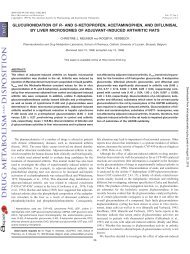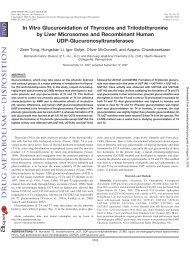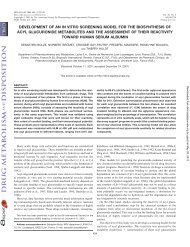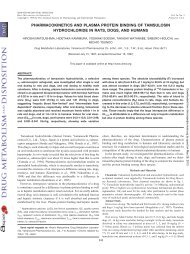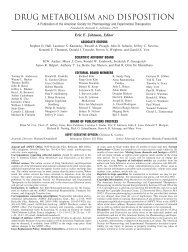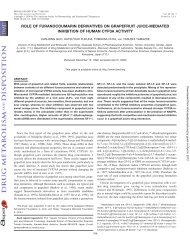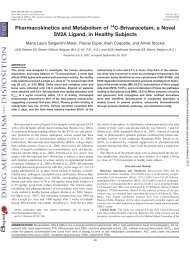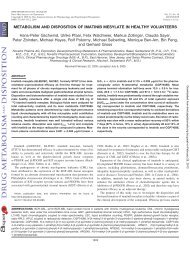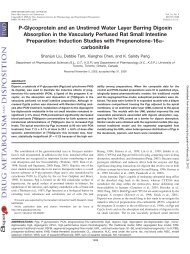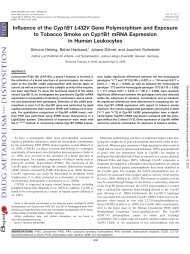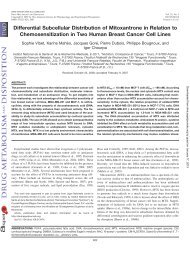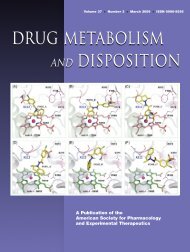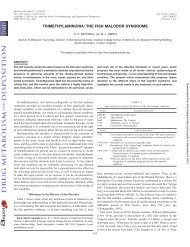Structure and stereochemistry of the active metabolite of
Structure and stereochemistry of the active metabolite of
Structure and stereochemistry of the active metabolite of
You also want an ePaper? Increase the reach of your titles
YUMPU automatically turns print PDFs into web optimized ePapers that Google loves.
0090-9556/02/3011-1288–1295$7.00<br />
DRUG METABOLISM AND DISPOSITION Vol. 30, No. 11<br />
Copyright © 2002 by The American Society for Pharmacology <strong>and</strong> Experimental Therapeutics 707/1015352<br />
DMD 30:1288–1295, 2002 Printed in U.S.A.<br />
STRUCTURE AND STEREOCHEMISTRY OF THE ACTIVE METABOLITE OF<br />
CLOPIDOGREL<br />
JEAN-MARIE PEREILLO, MOHAMED MAFTOUH, ALAIN ANDRIEU, MARIE-FRANCOISE UZABIAGA,<br />
OLIVIER FEDELI, PIERRE SAVI, MARC PASCAL, JEAN-MARC HERBERT, JEAN-PIERRE MAFFRAND, AND CLAUDINE PICARD<br />
ABSTRACT:<br />
Clopidogrel (SR25990C, PLAVIX) is a potent antiplatelet drug,<br />
which has been recently launched <strong>and</strong> is indicated for <strong>the</strong> prevention<br />
<strong>of</strong> vascular thrombotic events in patients at risk. Clopidogrel is<br />
in<strong>active</strong> in vitro, <strong>and</strong> a hepatic biotransformation is necessary to<br />
express <strong>the</strong> full antiaggregating activity <strong>of</strong> <strong>the</strong> drug. Moreover,<br />
2-oxo-clopidogrel has been previously suggested to be <strong>the</strong> essential<br />
key intermediate <strong>metabolite</strong> from which <strong>the</strong> <strong>active</strong> <strong>metabolite</strong> is<br />
formed. In <strong>the</strong> present paper, we give <strong>the</strong> evidence <strong>of</strong> <strong>the</strong> occurrence<br />
<strong>of</strong> an in vitro <strong>active</strong> <strong>metabolite</strong> after incubation <strong>of</strong> 2-oxoclopidogrel<br />
with human liver microsomes. This <strong>metabolite</strong> was<br />
purified by liquid chromatography, <strong>and</strong> its structure was studied by<br />
a combination <strong>of</strong> mass spectometry (MS) <strong>and</strong> NMR experiments.<br />
Clopidogrel (SR25990C, PLAVIX) is a potent antiaggregant <strong>and</strong><br />
antithrombotic drug, as demonstrated in several experimental models<br />
<strong>of</strong> thrombosis (Herbert et al., 1993a). The drug was launched on <strong>the</strong><br />
market following a successful clinical evaluation (Feliste et al., 1987)<br />
<strong>and</strong> demonstration <strong>of</strong> superior efficacy versus aspirin in preventing<br />
thrombotic events (myocardial infarction, stroke, <strong>and</strong> vascular death)<br />
in high risk patients (CAPRIE Steering Committee, 1996).<br />
Clopidogrel inhibits platelet aggregation ex vivo induced by ADP, low<br />
concentrations <strong>of</strong> thrombin, or by collagen (CAPRIE Steering Committee,<br />
1996). The specific pharmacological target <strong>of</strong> clopidogrel is <strong>the</strong><br />
ADP-induced platelet activation process (Herbert et al., 1993b), <strong>and</strong> it has<br />
been described as a specific <strong>and</strong> irreversible inhibitor <strong>of</strong> 2-methyl-S-ADP<br />
binding to its platelet receptors, <strong>the</strong> purinergic P2Y12 receptor (Savi et<br />
al., 1994a; Herbert et al., 1999; Savi et al., 2001). Clopidogrel is not<br />
<strong>active</strong> in vitro, <strong>and</strong> a biotransformation by <strong>the</strong> liver is necessary to allow<br />
<strong>the</strong> expression <strong>of</strong> its antiaggregating activity (Savi et al., 1992). Therefore,<br />
clopidogrel can be considered as a precursor <strong>of</strong> an <strong>active</strong> <strong>metabolite</strong>.<br />
Moreover, no antiaggregating activity was found in platelet poor plasma<br />
<strong>of</strong> SR25990C-treated animals or humans, indicating a high reactivity <strong>and</strong><br />
instability <strong>of</strong> <strong>the</strong> <strong>active</strong> <strong>metabolite</strong>.<br />
Clopidogrel has an absolute S configuration at carbon 7 (see chemical<br />
structure in Fig. 1). The corresponding R enantiomer is totally devoid <strong>of</strong><br />
antiaggregating activity (Savi et al., 1994b), thus indicating <strong>the</strong> importance<br />
<strong>of</strong> <strong>the</strong> configuration <strong>of</strong> this asymmetric carbon for <strong>the</strong> biological<br />
activity. In previous experiments, incubation <strong>of</strong> clopidogrel with rat<br />
Address correspondence to: Claudine Picard, 195 route d’Espagne, 31036<br />
Toulouse cedex, France. E-mail: claudine.picard@san<strong>of</strong>i-syn<strong>the</strong>labo.com<br />
San<strong>of</strong>i-Syn<strong>the</strong>labo Recherche, Toulouse cedex, France<br />
(Received February 15, 2002; accepted July 19, 2002)<br />
This article is available online at http://dmd.aspetjournals.org<br />
1288<br />
MS results suggested that <strong>the</strong> <strong>active</strong> <strong>metabolite</strong> belongs to a family<br />
<strong>of</strong> eight stereoisomers with <strong>the</strong> following primary chemical structure:2-{1-[1-(2-chlorophenyl)-2-methoxy-2-oxoethyl]-4-sulfanyl-3piperidinylidene}acetic<br />
acid. Chiral supercritical fluid chromatography<br />
resolved <strong>the</strong>se isomers. However, only one <strong>of</strong> <strong>the</strong> eight<br />
<strong>metabolite</strong>s retained <strong>the</strong> biological activity, thus underlining <strong>the</strong><br />
critical importance <strong>of</strong> associated absolute configuration. Because<br />
<strong>of</strong> its highly labile character, probably due to a very re<strong>active</strong> thiol<br />
function, structural elucidation <strong>of</strong> <strong>the</strong> <strong>active</strong> <strong>metabolite</strong> was performed<br />
on <strong>the</strong> stabilized acrylonitrile derivative. Conjunction <strong>of</strong> all<br />
our results suggested that <strong>the</strong> <strong>active</strong> <strong>metabolite</strong> is <strong>of</strong> S configuration<br />
at C 7 <strong>and</strong> Z configuration at C 3–C 16 double bound.<br />
hepatic microsomes was found to generate 2-oxo-clopidogrel, through a<br />
CYP450-dependent pathway <strong>of</strong> metabolism (Savi et al., 1992, 1994b).<br />
Similar results were obtained using human liver microsomes (Savi et al.,<br />
2000). Despite being not <strong>active</strong> in vitro, 2-oxo-clopidogrel can demonstrate<br />
an antiaggregating activity ex vivo, thus indicating that <strong>the</strong> formation<br />
<strong>of</strong> <strong>the</strong> <strong>active</strong> <strong>metabolite</strong> <strong>of</strong> clopidogrel occurred downstream to <strong>the</strong><br />
formation <strong>of</strong> 2-oxo-clopidogrel (Savi et al., 2000). The structure <strong>of</strong> <strong>active</strong><br />
<strong>metabolite</strong> <strong>of</strong> ano<strong>the</strong>r thienopyridine, CS-747, was reported (Sugidachi et<br />
al., 2000, 2001). In ano<strong>the</strong>r report, <strong>the</strong>se authors indicated <strong>the</strong> precise<br />
absolute configuration to express <strong>the</strong> biological activity, since only one<br />
among <strong>the</strong> four optical isomers showed activity in inhibiting platelet<br />
aggregation (Kazui et al., 2001). However, to our knowledge, no structural<br />
<strong>and</strong> stereochemical characterization data were published in detail<br />
concerning this <strong>active</strong> <strong>metabolite</strong>.<br />
The objective <strong>of</strong> this work was to identify <strong>the</strong> chemical structure <strong>of</strong><br />
<strong>the</strong> <strong>active</strong> <strong>metabolite</strong> <strong>of</strong> clopidogrel. For this purpose, <strong>metabolite</strong>s<br />
generated after incubation <strong>of</strong> human liver microsomes with 2-oxoclopidogrel<br />
<strong>and</strong> its corresponding in<strong>active</strong> R enantiomer were isolated<br />
<strong>and</strong> purified using a two-step liquid chromatographic procedure. The<br />
biological activity <strong>of</strong> <strong>the</strong> <strong>metabolite</strong>s was evaluated through <strong>the</strong> inhibition<br />
<strong>of</strong> binding <strong>of</strong> radiolabeled 2-methyl-S-ADP to rat platelets.<br />
Subsequently, <strong>the</strong> structure <strong>and</strong> <strong>stereochemistry</strong> <strong>of</strong> <strong>the</strong> <strong>metabolite</strong>s<br />
were studied by a combination <strong>of</strong> mass spectrometry (MS 1 ), NMR,<br />
<strong>and</strong> chiral supercritical fluid chromatography (chiral SFC).<br />
1 Abbreviations used are: MS, mass spectrometry; SFC, supercritical fluid<br />
chromatography; PRP, platelet-rich plasma; HPLC, high-performance liquid chromatography;<br />
ESI, positive electrospray ionization; amu, atomic mass unit(s);<br />
MS/MS, t<strong>and</strong>em mass spectrometry; EI, electron impact; CI, chemical ionization;<br />
DQF, double quantum-filtered correlation spectroscopy; ROESY, rotating frame<br />
Downloaded from<br />
dmd.aspetjournals.org by guest on December 10, 2012
FIG. 1.Chemical structure <strong>of</strong> clopidogrel.<br />
Materials <strong>and</strong> Methods<br />
Chemicals. Clopidogrel (SR25990C, 2-(2-chlorophenyl)-2-(2,4,5,6,7,7a<br />
hexahydrothieno [3,2c]pyridine-5yl-acetic acid methylester hydrogen sulfate,<br />
7S) <strong>and</strong> its corresponding in<strong>active</strong> levogyre enantiomer (SR25989C, 7R) were<br />
made available from San<strong>of</strong>i-Synthélabo Recherche (Toulouse, France). 2-Oxoclopidogrel<br />
[(7S) SR121683] <strong>and</strong> 2-oxo-SR25989C [(7R) SR121682] were<br />
prepared by semipreparative chiral HPLC from <strong>the</strong> racemic (7R,S) SR25552,<br />
which was syn<strong>the</strong>sized by San<strong>of</strong>i-Synthélabo Recherche. 33 P-2-Methyl-S-ADP<br />
(600 Ci/mmol) was from PerkinElmer Life Sciences (Le Blanc Mesnil,<br />
France). Gluthatione, reduced form, <strong>and</strong> �-nicotinamide adenosine diphosphate,<br />
reduced form (NADPH), were from Sigma-Aldrich (L’Ile d’Abeau,<br />
France). All o<strong>the</strong>r chemicals were <strong>of</strong> analytical or HPLC grade.<br />
Purification <strong>of</strong> Clopidogrel Metabolites from Incubation <strong>of</strong> 2-Oxoprecursors<br />
with Human Liver Microsomes. Human liver microsomes from<br />
BD Gentest (Woburn, MA) were adjusted to 0.75 mg <strong>of</strong> protein/ml in 100 mM<br />
potassium phosphate buffer, pH 7.4, containing 100 mM KF <strong>and</strong> 10 mM<br />
gluthatione. SR121682 <strong>and</strong> SR121683 were added at a final concentration <strong>of</strong><br />
0.1 mM, <strong>and</strong> <strong>the</strong> reaction was initiated with 1 mM NADPH. Incubation was<br />
carried out at 37°C under continuous stirring (100 rpm) <strong>and</strong> light protection<br />
using a reciprocal incubator. After 60 min, <strong>the</strong> incubation medium was cooled<br />
at 4°C <strong>and</strong> centrifuged at 10,000g for 10 min.<br />
A first purification step for isolation <strong>of</strong> <strong>metabolite</strong>s was performed by<br />
semipreparative liquid chromatography on a system from Pharmacia AB<br />
(Uppsala, Sweden). The incubation supernatants were loaded on a HR16/5<br />
precolumn (50 � 16 mm) from Pharmacia AB, filled with a 10-�m C 18<br />
support from Millipore Corporation (Epernon, France). The precolumn was<br />
rinsed <strong>and</strong> equilibrated with a 10 mM ammonium acetate buffer (pH 6.5). The<br />
precolumn was <strong>the</strong>n coupled to a 10-�m Kromasil C 18 column from Akzo<br />
Nobel (Bohus, Sweden). Elution at 2.0 ml/min was performed using an<br />
acetonitrile/10 mM ammonium acetate gradient (10 to 90%) <strong>and</strong> monitored<br />
with a dual UV detection (214 nm/254 nm). Eluted fractions were collected<br />
<strong>and</strong> concentrated to 300 �l using a SpeedVac vacuum centrifuge evaporator<br />
from Savant Instruments (Holbrook, NY).<br />
The eluted fraction “H” that contains a pool <strong>of</strong> <strong>metabolite</strong>s was controlled<br />
by analytical HPLC using a Superspher 60RP8-E column (125 � 4 mm) from<br />
Merck-Clevenot (Nogent/Marne, France). Isocratic elution was performed at<br />
0.8 ml/min with 60% methanol in aqueous 0.2% acetic acid/0.1% diethylamine<br />
(pH 5.5) <strong>and</strong> monitored with UV detection at 234 nm.<br />
A second purification step using semipreparative HPLC was performed to<br />
separate individual <strong>metabolite</strong>s from <strong>the</strong> fraction “H”, using an Ultrabase<br />
UB225 column (250 � 4.6 mm) from SFCC (Neuilly-Plaisance, France).<br />
Elution was performed at 1 ml/min using an acetonitrile/10 mM ammonium<br />
acetate (pH 6.5) gradient (10 to 24%) with UV detection at 234 nm. The<br />
collected fractions were concentrated on <strong>the</strong> SpeedVac evaporator.<br />
Concentrations <strong>of</strong> native “H” <strong>metabolite</strong>s were estimated by analytical<br />
HPLC, using ticlopidine as an external st<strong>and</strong>ard for quantitative calibration.<br />
Ticlopidine was chosen because it can be eluted by <strong>the</strong> same analytical HPLC<br />
method as <strong>the</strong> “H” <strong>metabolite</strong>s, whereas this is not possible with <strong>the</strong> more<br />
hydrophobic clopidogrel. In addition, ticlopidine has <strong>the</strong> same thiophene <strong>and</strong><br />
2-chlorophenyl chromophore groups than clopidogrel. This quantification approach<br />
was validated using incubation <strong>of</strong> radiolabeled 14 C-clopidogrel (35.5<br />
�Ci/mg, Isotopic Chemistry Department, San<strong>of</strong>i-Syn<strong>the</strong>labo Research, Alnwick,<br />
UK) to correlate <strong>the</strong> concentrations measured by UV <strong>and</strong> specific<br />
radioactivity, using <strong>the</strong> analytical control HPLC method described above.<br />
nuclear Overhauser enhancement spectroscopy; HSQC, heteronuclear single<br />
quantum correlation; LC, liquid chromatrography.<br />
THE ACTIVE METABOLITE OF CLOPIDOGREL<br />
1289<br />
In Vitro Activity <strong>of</strong> Clopidogrel Metabolites on <strong>the</strong> Binding <strong>of</strong> 33P-<br />
2MeS-ADP Human Platelets. Venous blood was collected on citrated tubes<br />
from human healthy volunteers. PRP was obtained by centrifugation (120g, 10<br />
min), <strong>and</strong> PRP samples (2 ml) were incubated for1hat20°C with <strong>the</strong> purified<br />
<strong>metabolite</strong>s. Experiments on <strong>the</strong> specific binding <strong>of</strong> 33 P-2MeS-ADP to human<br />
platelets were performed using a filtration technique to separate <strong>the</strong> free from<br />
bound 33 P-2MeS-ADP as previously described (Savi et al., 1994). The preincubated<br />
PRPs were centrifuged (600g, 10 min.), <strong>the</strong>n <strong>the</strong> supernatants were<br />
discarded, <strong>and</strong> <strong>the</strong> pellets were resuspended in binding buffer (145 mM NaCl,<br />
5 mM KCl, 0.1 mM MgCl 2, 5.5 mM glucose, 15 mM HEPES, 5 mM EDTA).<br />
Incubations <strong>of</strong> <strong>the</strong> 2-oxo metabolic precursors (SR25552, SR121683, <strong>and</strong><br />
SR121682) were carried out in 0.2 ml <strong>of</strong> binding buffer, which contained<br />
washed human platelets (0.1 � 10 9 platelets/ml) <strong>and</strong> 33 P-2MeS-ADP (0.5 nM).<br />
Triplicate incubations were carried out at 37°C for 15 min <strong>and</strong> were terminated<br />
by <strong>the</strong> addition <strong>of</strong> a 3-ml ice-cold assay buffer followed by rapid vacuum<br />
filtration over glass-fibber Filtermats 11734 from Skatron Instruments (Sterling,<br />
VA). Filters were <strong>the</strong>n washed twice with 5-ml ice-cold incubation buffer,<br />
dried, <strong>and</strong> <strong>the</strong> radioactivity was measured by scintillation counting. Nonspecific<br />
binding was defined as <strong>the</strong> total binding measured in <strong>the</strong> presence <strong>of</strong><br />
excess unlabeled ADP (1 mM), <strong>and</strong> specific binding was defined as <strong>the</strong><br />
difference between total binding <strong>and</strong> nonspecific binding. The percent inhibition<br />
was expressed as %I � (total binding � total binding with antagonist)/<br />
specific binding �100.<br />
Derivatization <strong>of</strong> Clopidogrel Metabolites with Acrylonitrile. The fraction<br />
H containing <strong>the</strong> <strong>metabolite</strong>s from microsomal incubation with 2-oxoprecursors<br />
(SR25552, SR121683, or SR121682) was diluted in an excess <strong>of</strong><br />
acrylonitrile. After overnight agitation at room temperature, <strong>the</strong> solutions were<br />
evaporated to dryness with a SpeedVac system. The derivatized <strong>metabolite</strong>s<br />
were <strong>the</strong>n purified ei<strong>the</strong>r by semipreparative HPLC as described for native<br />
<strong>metabolite</strong>s or by analytical HPLC system using a 5-�m Kromasil C 18 column<br />
(100 � 4.6 mm) <strong>and</strong> an acetonitrile/0.1% trifluoroacetic acid gradient (18 to<br />
25%). Concentrations <strong>of</strong> derivatized <strong>metabolite</strong>s were estimated by analytical<br />
HPLC, as described above for native <strong>metabolite</strong>s.<br />
Mass Spectrometry LC/MS <strong>and</strong> LC/MS/MS <strong>of</strong> native <strong>metabolite</strong>s. Fraction<br />
H from microsomal incubation with <strong>the</strong> racemic 2-oxo-precursor SR25552 was<br />
injected on a Lichrocart 60RP8E column (125 � 4 mm) from Merck-Clevenot<br />
using a HP1100 liquid chromatograph from Agilent Technologies (Waldbronn,<br />
Germany). Isocratic elution was performed with a mixture <strong>of</strong> methanol/water/<br />
acetic acid/diethylamine (40:60:0.2:0.1 v/v/v/v) at 0.7 ml/min, <strong>and</strong> UV signal<br />
was followed at 254 nm. MS data were acquired on a Finnigan LCQ instrument<br />
from Thermoquest (San Jose, CA) in positive electrospray ionization (ESI � )<br />
mode. The spray potential was set at 5.6 kV <strong>and</strong> capillary temperature at<br />
230°C. Mass range was scanned between 100 <strong>and</strong> 900 amu. In MS/MS mode<br />
(23% <strong>of</strong> collision energy), <strong>the</strong> two parent ions obtained at m/z 356.5 <strong>and</strong> 358.5<br />
(with 1.4 amu peak width) correspond, respectively, to <strong>the</strong> quasi-molecular<br />
ions <strong>of</strong> <strong>the</strong> <strong>metabolite</strong>s containing ei<strong>the</strong>r 35 Cl or 37 Cl isotope.<br />
EI <strong>and</strong> CI mass spectrometry <strong>of</strong> methyl-derivatized <strong>metabolite</strong>s. Fraction H<br />
from SR25552 was derivatized using e<strong>the</strong>real diazomethane reaction. MS<br />
analyses using electron impact (EI) <strong>and</strong> chemical ionization (CI) were done on<br />
a Finnigan TSQ 700 mass spectrometer from Thermoquest. EI was performed<br />
at 70 eV, <strong>and</strong> scans were taken over <strong>the</strong> mass range m/z 40 to 500, whereas CI<br />
was conducted using ammonia as reactant gas, <strong>and</strong> scans were taken over <strong>the</strong><br />
mass range <strong>of</strong> m/z 80 to 900. Both direct introductions were done using a probe<br />
with a current gradient from 50 to 800 mA in 2 min.<br />
LC/MS <strong>of</strong> acrylonitrile-derivatized <strong>metabolite</strong>s. Fraction H from SR25552<br />
was derivatized with acrylonitrile <strong>and</strong> analyzed on <strong>the</strong> TSQ 700 mass spectrometer<br />
using <strong>the</strong> same conditions as for <strong>the</strong> native metabolic fraction H.<br />
Chiral Supercritical Fluid Chromatography. The acrylonitrile-derivatized<br />
H <strong>metabolite</strong>s from microsomal incubation with ei<strong>the</strong>r 2-oxo-precursor<br />
SR121683 or SR121682 were analyzed by SFC using a chromatograph from<br />
Berger Instruments Inc. (Newark, DE). The system comprises a FCM-1200<br />
fluid control module for pumping carbon dioxide <strong>and</strong> polar modifier, a TCM-<br />
2020 column <strong>the</strong>rmal control module, an ALS-3150 autosampler, a DAD-4100<br />
diode-array UV detector, an electronic back-pressure regulator, <strong>and</strong> a Chem-<br />
Station s<strong>of</strong>tware (Agilent Technologies) for instrument control <strong>and</strong> data acquisition/processing.<br />
Separation was achieved using a Chiralpak-AD column<br />
(250 � 4.6 mm) from Daicel Chemicals (Tokyo, Japan) <strong>and</strong> a carbon dioxide/<br />
isopropanol containing 0.4% triethylamine <strong>and</strong> 0.4% trifluoroacetic acid<br />
Downloaded from<br />
dmd.aspetjournals.org by guest on December 10, 2012
1290 PEREILLO ET AL.<br />
FIG. 2.Semipreparative HPLC purification chromatograms <strong>and</strong> biological<br />
activity <strong>of</strong> <strong>the</strong> collected fractions from incubations <strong>of</strong> (7S) SR121683 (A <strong>and</strong> B)<br />
<strong>and</strong> (7R) SR121682 (C <strong>and</strong> D) with human microsomes.<br />
(90:10 v/v) mixture as fluid eluent. The operating conditions were 3 ml/min<br />
flow rate, 200 bar outlet pressure, <strong>and</strong> 5°C column temperature. The sample<br />
was dissolved in an isopropanol/methylene chloride (v/v) mixture <strong>and</strong> 10 �l<br />
were injected. UV detection was carried out at 220 nm.<br />
FIG. 3.Analytical HPLC control chromatograms <strong>of</strong> <strong>metabolite</strong>s pool H from<br />
incubation <strong>of</strong> (7S) SR121683 (A) <strong>and</strong> (7R) SR121682 (B) with human<br />
microsomes.<br />
Nuclear Magnetic Resonance. 1 H (500.13 MHz) <strong>and</strong> 13 C (125.77 MHz)<br />
NMR spectra <strong>of</strong> acrylonitrile-derivatized H <strong>metabolite</strong>s from microsomal<br />
incubation with racemic 2-oxo-precursor SR25552 were recorded on an<br />
Avance DRX500 spectrometer from Bruker (Karlsruhe, Germany). The probe<br />
was a 1 H/ 13 C 5 mm, 3 axis gradients (x,y,z), optimized for inverse detection.<br />
Spectra were recorded in CDCl 3 solvent in 5-mm tubes without spinning at a<br />
temperature <strong>of</strong> 300K. Sample concentration was less than 1 mg in 0.5 ml. The<br />
residual protonated resonance <strong>of</strong> <strong>the</strong> solvent (CDCl 3) was used as an internal<br />
chemical shift st<strong>and</strong>ard, which was related to tetramethylsilane with chemical<br />
shifts <strong>of</strong> 7.25 <strong>and</strong> 77 ppm, respectively, for 1 H <strong>and</strong> 13 C. The pulse programs <strong>of</strong><br />
all 2D experiments (gradient-selected COSY, gradient-selected DQF-COSY,<br />
ROESY <strong>and</strong> gradient selected 1 H/ 13 C HSQC) were taken from <strong>the</strong> Bruker<br />
st<strong>and</strong>ard s<strong>of</strong>tware library. Processing <strong>of</strong> <strong>the</strong> raw data were performed using<br />
Bruker XWinNmr s<strong>of</strong>tware running on a Silicon Graphics Indy workstation.<br />
The pulse conditions were 90° pulse, 6.8 �s (attenuation 0db) for 1H <strong>and</strong> 5 �s<br />
(attenuation �2db) for 13 C. Gradient pulses used in this study were all shaped<br />
to a sine envelope with 1 ms duration (COSY, DQF-COSY, <strong>and</strong> 1 H/ 13 C<br />
HSQC). Spectral width was 5530.97 Hz for proton <strong>and</strong> 34013.6 Hz for carbon.<br />
The main acquisition <strong>and</strong> processing parameters were as follows: 1 H-1D<br />
spectrum, 1024 scans, time domain size � 64K; 1 H-2D gradient selected<br />
COSY, 16 scans, time domain size � 2K in t2, 512 experiments in t1, gradient<br />
amplitude 10:10 G.cm-1, zero-filling up to 2K in t1, sinus filter in t1 <strong>and</strong> t2;<br />
Downloaded from<br />
dmd.aspetjournals.org by guest on December 10, 2012
TABLE 1<br />
Biological activity <strong>of</strong> native H1 to H4 <strong>metabolite</strong> fractions (1 �M equivalent) on<br />
33<br />
P-2MeS-ADP binding to platelets<br />
Metabolite Concentration<br />
Inhibition <strong>of</strong> 33 P-2MeS-<br />
ADP binding<br />
�M %<br />
H1 Not determined 0<br />
H2 Not determined 0<br />
H3 39.7 0<br />
H4 22.2 83<br />
1 H-2D gradient selected DQF-COSY, 64 scans, time domain size � 2K in t2,<br />
512 experiments in t1, gradient amplitude 15:30 G.cm-1, zero-filling up to 2K<br />
in t1, cosinus2 filter in t1 <strong>and</strong> t2; 1 H-2D ROESY spectrum, 32 scans, time<br />
domain size � 2K in t2, 512 experiments in t1, 300 ms mixing time, zer<strong>of</strong>illing<br />
up to 2K in t1, cosinus2 filter in both t1 <strong>and</strong> t2; 13 C-1D decoupled<br />
spectrum: 10 000 scans, time domain size � 16K, decoupling 1H using<br />
WALTZ16, exponential filter with a time constant <strong>of</strong> 3Hz before Fourier<br />
transformation; 1 H/ 13 C 2D gradient selected HSQC, 64 scans, time domain<br />
size � 2K in t2, 128 experiments in t1, gradient amplitude 40:10:40:�10<br />
G.cm-1, decoupling 13 C using globally optimized alternating-phase rectangular<br />
pulses, delay optimized for an average 1 J CH-coupling constant <strong>of</strong> 131 Hz,<br />
zero-filling up to 2K in t1, cosinus2 filter in t1 <strong>and</strong> t2.<br />
Molecular Modeling. Conformational analysis was performed using <strong>the</strong><br />
SYBIL s<strong>of</strong>tware from Tripos Inc.(St. Louis, MO) running on a Silicon Graphics<br />
R10000 workstation. The goal <strong>of</strong> this modelisation was to explore <strong>the</strong><br />
conformational space <strong>of</strong> <strong>the</strong> acrylonitrile-derivatized H <strong>metabolite</strong>s. Molecular<br />
dynamics studies were carried out using a method called “high temperature”<br />
(600K) during 1 ps. Results were used to find a minimum <strong>of</strong> energy for each<br />
structure. The force field used to perform dynamic experiments <strong>and</strong> energy<br />
minimization were those <strong>of</strong> Tripos. These calculations allowed finding a<br />
privileged conformation for each molecule.<br />
Results<br />
Biotransformation <strong>of</strong> 2-Oxo-clopidogrel into an Active Metabolite.<br />
The <strong>active</strong> <strong>metabolite</strong> <strong>of</strong> clopidogrel (SR25990C) was suspected<br />
to be formed downstream to <strong>the</strong> formation <strong>of</strong> 2-oxo-clopidogrel<br />
following incubation <strong>of</strong> human liver microsomes with <strong>the</strong> latter.<br />
Parallel incubations were carried out with <strong>the</strong> 2-oxo-clopidogrel<br />
(SR121683) <strong>and</strong> its opposite in<strong>active</strong> R enantiomer (SR121682) as a<br />
control. Only SR121683 could demonstrate ex vivo biological activity<br />
(Savi et al., 2000), supporting <strong>the</strong> fact that SR121683 is <strong>the</strong> 2-oxo-<br />
SR25990C <strong>and</strong> <strong>the</strong>refore should have an S configuration at carbon 7.<br />
The <strong>metabolite</strong>s present in <strong>the</strong> supernatant <strong>of</strong> incubates were isolated<br />
in a single fraction using semipreparative chromatography. SR121683<br />
<strong>and</strong> SR121682 generated similar elution patterns (data not shown),<br />
indicating an identical metabolic pathway. An inhibitory effect <strong>of</strong><br />
33<br />
P-2-methyl-S-ADP binding to platelets was found only in a fraction<br />
from <strong>the</strong> SR121683 incubate, named fraction H.<br />
To determine which peak(s) bore <strong>the</strong> biological activity, fraction H<br />
derived from SR121683 was fur<strong>the</strong>r separated by semipreparative<br />
HPLC (Fig. 2A), <strong>and</strong> activity was assessed on <strong>the</strong> eluted fractions by<br />
measuring 33 P-2-methyl-S-ADP binding to human platelets (Fig. 2B).<br />
Similar purification was performed for fraction H derived from<br />
SR121682 (Fig. 2, C <strong>and</strong> D). As expected, <strong>the</strong> activity could be<br />
detected only in SR121683 derived <strong>metabolite</strong>s (mainly in fractions 5<br />
<strong>and</strong> 6), <strong>metabolite</strong>s from SR121682 being not <strong>active</strong>. Fraction H from<br />
SR121683 was fur<strong>the</strong>r resolved by analytical HPLC (Fig. 3A). Four<br />
different peaks were observed <strong>and</strong> named H1, H2, H3, <strong>and</strong> H4<br />
according to <strong>the</strong>ir elution order. The fractions tested for biological<br />
activity (Fig. 2A) were checked by <strong>the</strong> same analytical HPLC method.<br />
In <strong>the</strong> collected fraction 6, only H4 was detected, whereas fraction 4<br />
contained 13% H1 <strong>and</strong> 87% H3 <strong>and</strong> fraction 5 contained 51% H2,<br />
28% H3, <strong>and</strong> 21% H4. Again, a similar four peak analytical HPLC<br />
THE ACTIVE METABOLITE OF CLOPIDOGREL<br />
1291<br />
FIG. 4.LC/MS <strong>and</strong> LC/MS/MS spectra <strong>of</strong> <strong>metabolite</strong>s pool H, showing UV (A)<br />
<strong>and</strong> MS total current trace for MH� at m/z 356.5 ion (B), ESI�/MS spectrum for<br />
peak H4 (C), ESI� MS/MS spectrum <strong>of</strong> m/z 356.5 ion (MH � bearing 35 Cl isotope,<br />
D) <strong>and</strong> ESI�/MS/MS spectrum <strong>of</strong> m/z 358.5 ion (MH � bearing 37 Cl isotope, E).<br />
Downloaded from<br />
dmd.aspetjournals.org by guest on December 10, 2012
1292 PEREILLO ET AL.<br />
FIG. 5.Primary structure <strong>of</strong> <strong>the</strong> <strong>active</strong> H4 <strong>metabolite</strong> <strong>of</strong> clopidogrel <strong>and</strong> MS<br />
fragmentation pathway proposal from ESI�/MS/MS data.<br />
Spectra were obtained on MH� bearing 35 Cl <strong>and</strong> 37 Cl isotopes. �, selected ion<br />
m/z 356.5. ��, selected ion m/z 358.5.<br />
pr<strong>of</strong>ile with almost <strong>the</strong> same retention times was obtained with <strong>the</strong><br />
SR121682-derived metabolic pool (Fig. 3B). The four H1 to H4 peaks<br />
from SR121683 incubates were collected <strong>and</strong> separately checked for<br />
<strong>the</strong>ir biological activity. Results shown in Table 1 indicate that only<br />
<strong>the</strong> fraction corresponding to <strong>the</strong> H4 peak contained an <strong>active</strong> <strong>metabolite</strong><br />
<strong>of</strong> clopidogrel.<br />
Structural Elucidation <strong>of</strong> <strong>the</strong> Active Metabolite. It was clearly<br />
demonstrated that <strong>the</strong> biological activity was supported by <strong>the</strong> S<br />
stereochemical configuration at carbon 7 <strong>of</strong> clopidogrel. It was also<br />
shown that <strong>the</strong> two achiral chromatographic pr<strong>of</strong>iles <strong>of</strong> metabolic pool<br />
“H” from ei<strong>the</strong>r oxo-precursor SR12683 or SR121682 microsomal<br />
incubates were similar (see Fig. 4). Hence, all <strong>the</strong> subsequent structural<br />
elucidation studies using nonstereoselective MS <strong>and</strong> NMR spectroscopy<br />
were carried out on metabolic pool “H” obtained by human<br />
microsomal incubation <strong>of</strong> <strong>the</strong> racemic 2-oxo-precursor (7S, 7R)<br />
SR25552.<br />
Mass spectrometry. LC/MS experiments were conducted on <strong>the</strong><br />
metabolic pool “H” from SR25552. Both UV <strong>and</strong> mass detection (m/z<br />
356–357) pr<strong>of</strong>iles demonstrated <strong>the</strong> presence <strong>of</strong> <strong>the</strong> four different<br />
peaks noted H1 to H4 (Fig. 4, A <strong>and</strong> B). The detected four peaks in<br />
MS had exactly <strong>the</strong> same characteristics with a molecular ion MH � at<br />
m/z 356.5, corresponding to 34 amu more than clopidogrel (Fig. 4C).<br />
The MS/MS data obtained on quasi-molecular ions MH � 356.5 <strong>and</strong><br />
358.5 containing 35 Cl or 37 Cl isotope, respectively, allowed <strong>the</strong> detection<br />
<strong>of</strong> fragments bearing a chlorine atom (Fig. 4, D <strong>and</strong> E).<br />
MS/MS data were <strong>the</strong> same for <strong>the</strong> four compounds <strong>and</strong> were found<br />
in accordance to <strong>the</strong> primary structure proposal <strong>and</strong> <strong>the</strong> fragmentation<br />
scheme shown in Fig. 5.<br />
SCHEME 1. Z or E isomer.<br />
To confirm <strong>the</strong> presence <strong>of</strong> a carboxylic acid function, metabolic pool<br />
“H” from SR25552 was derivatized with diazomethane. Results obtained<br />
in EI <strong>and</strong> CI ionisation modes confirmed <strong>the</strong> incorporation <strong>of</strong> two methyl<br />
groups in each <strong>of</strong> <strong>the</strong> four structures. The molecular M �� ion was<br />
observed at m/z 383 in <strong>the</strong> EI mass spectrum <strong>and</strong> MH � ion at m/z 384 in<br />
DCI � /NH3 mass spectrum (data not shown). These results were in good<br />
accordance with <strong>the</strong> proposed primary structure for clopidogrel <strong>metabolite</strong>s<br />
having a carboxylic acid function <strong>and</strong> a thiol group.<br />
Nuclear Magnetic Resonance. From <strong>the</strong> four diastereomer H1 to H4<br />
<strong>metabolite</strong>s generated from incubation <strong>of</strong> SR25552 with human microsomes<br />
<strong>and</strong> purified by HPLC, only H4 was shown to retain <strong>the</strong><br />
biological activity. This underlines <strong>the</strong> importance <strong>of</strong> a specific <strong>and</strong><br />
critical absolute configuration for <strong>the</strong> <strong>active</strong> <strong>metabolite</strong>, <strong>the</strong> exact<br />
nature <strong>of</strong> which remained to be elucidated using NMR. However <strong>the</strong><br />
<strong>active</strong> H fraction isolated by semipreparative chromatography or<br />
obtained after subsequent semipreparative HPLC purification, appeared<br />
to be highly labile since its activity was quickly lost after<br />
overnight incubation at room temperature. This could be explained by<br />
<strong>the</strong> presence <strong>of</strong> <strong>the</strong> re<strong>active</strong> thiol group on <strong>the</strong> proposed structure (Fig.<br />
5). Therefore, for all subsequent NMR studies, <strong>the</strong> “H” <strong>metabolite</strong>s<br />
were always stabilized by trapping <strong>the</strong> re<strong>active</strong> thiol group with<br />
acrylonitrile a thiol specific reagent, which was chosen because it did<br />
not introduce a supplementary asymmetric carbon in <strong>the</strong> chemical<br />
structure <strong>of</strong> <strong>the</strong> compound. The resulting acrylonitrile derivatives<br />
were controlled by LC/MS before use. They always gave <strong>the</strong> four<br />
HPLC separated H1 to H4 analog peaks, all <strong>of</strong> which exhibited a<br />
quasi-molecular ion MH� at m/z 409 thus confirming <strong>the</strong> introduction<br />
<strong>of</strong> an acrylonitrile group on <strong>the</strong> thiol function.<br />
Assignments <strong>of</strong> <strong>the</strong> resonance to individual proton <strong>and</strong> carbon<br />
nuclei <strong>of</strong> <strong>the</strong> molecules were performed according to <strong>the</strong> following<br />
numbering NMR nomenclature (Scheme 1).<br />
The set <strong>of</strong> NMR data were fully compatible with <strong>the</strong> chemical<br />
structure proposed above. All assignments were carried out using<br />
chemical shift tables, homonuclear 1 H coupling detected by <strong>the</strong> presence<br />
<strong>of</strong> cross peaks on correlation spectra (COSY, DQF-COSY),<br />
heteronuclear 1 H/ 13 C coupling detected by <strong>the</strong> presence <strong>of</strong> cross peaks<br />
on HSQC spectrum, <strong>and</strong> homonuclear 1 H dipolar coupling obtained<br />
from ROESY experiments. Table 2 shows 1 H <strong>and</strong> 13 C chemical shift<br />
assignments <strong>of</strong> derivatized H1, H3, <strong>and</strong> H4 <strong>metabolite</strong>s. Interpretable<br />
spectra for <strong>the</strong> derivatized H2 <strong>metabolite</strong> were not obtained due to<br />
insufficient amount <strong>of</strong> purified compound.<br />
Conformational analysis <strong>and</strong> configuration <strong>of</strong> <strong>the</strong> ethylenic bond.<br />
Molecular modeling calculations were performed taking into account<br />
NMR constraints ( 1 H homonuclear long range couplings <strong>and</strong> nuclear<br />
Overhauser effects). Conformations corresponding to energy minima<br />
Downloaded from<br />
dmd.aspetjournals.org by guest on December 10, 2012
Nuclei<br />
Number<br />
TABLE 2<br />
1 13<br />
H- <strong>and</strong> C-NMR chemical shifts <strong>of</strong> acrylonitrile-derivatized H1, H3, <strong>and</strong> H4 <strong>metabolite</strong>s<br />
Derivatized H1 Metabolite Derivatized H3 Metabolite Derivatized H4 Metabolite<br />
� 1 H (multiplicity, integral) � 13 C � 1 H (multiplicity, integral) � 13 C � 1 H (multiplicity, integral) � 13 C<br />
1 (N)<br />
2 3.57 (d, 1H) 46.8 3.56 (d, 1H) 53.9 3.66 (d, 1H) 54.3<br />
2� 4.37 (d, 1H) 2.94 (d, 1H) 3.15 (d, 1H)<br />
3 ND 157.5 157.3<br />
4 3.61 (s, 1H) 48.3 5.17 (d, 1H) 38.3 5.18 (d, 1H) 38.5<br />
5 2.26–2.41 (m, 1H) 31.6 2.22–2.31 (m, 1H) 31.3 2.15–2.25 (m, 1H) 31.2<br />
5� 1.87 (d, 1H) 1.92 (d, 1H) 1.83–1.89 (m, 1H)<br />
6 2.73–2.84 (m, 2H) 46.1 2.86 (d, 1H) 46.3 2.62–2.67 (m, 2H) 46.1<br />
6� 2.74 (m, 1H)<br />
7 4.88 (s, 1H) 67.1 4.80 (s, 1H) 67.8 4.80 (s, 1H) 67.8<br />
8 134.7 134.6 134.8<br />
9 133.2 133.6 133.1<br />
10<br />
11 7.22–7.58 (m, 4H) 127.1 7.24–7.62 (m, 4H) 126 7.25–7.58 (m, 4H) 127.2<br />
12 to to to<br />
13 130 130 130.1<br />
14 171.2 171.1 170.9<br />
15 3.71 (s, 3H) 52.2 3.70 (s, 3H) 51.9 3.70 (s, 3H) 52.3<br />
16 5.78 (s, 1H) 118.1 5.70 (s, 1H) 115.6 5.80 (s, 1H) 116<br />
17 ND 169.3 169.2<br />
18 (S)<br />
19 26.7 26.5 26.5<br />
19� 2.61–2.66 (m, 4H) 2.60–2.73 (m, 4H) 2.68–2.75 (m, 4H)<br />
20 18.7 18.8 19<br />
20�<br />
21 ND 118.2 118.4<br />
ND, not determined; s, singlet; d, Doublet; m, multiplet.<br />
SCHEME 2. Calculated structure for both E <strong>and</strong> Z double bond configuration.<br />
were sought. In <strong>the</strong>se conformers, <strong>the</strong> piperidine group adopted a chair<br />
conformation with <strong>the</strong> SCH 2CH 2CN group in axial position. Indeed,<br />
it seems that <strong>the</strong> equatorial position was unfavorable for <strong>the</strong><br />
SCH 2CH 2CN group (�3 kCal) due to steric constraints induced by<br />
<strong>the</strong> bulky sulfur group.<br />
Scheme 2 shows <strong>the</strong> calculated structure for both E <strong>and</strong> Z double<br />
bond configuration, toge<strong>the</strong>r with estimated internuclei distances. For<br />
derivatized H3 <strong>and</strong> H4 <strong>metabolite</strong>s, ROESY experiments exhibit cross<br />
peak between protons 2� <strong>and</strong> 16 but no cross peak between proton 4<br />
<strong>and</strong> 16. For derivatized H1, ROESY experiments exhibit a cross peak<br />
between protons 4 <strong>and</strong> 16 <strong>and</strong> no cross peak between protons 2� <strong>and</strong><br />
16. It was <strong>the</strong>n deduced that H3 <strong>and</strong> H4 have <strong>the</strong> same Z configuration,<br />
H1 being <strong>of</strong> <strong>the</strong> E configuration. This is confirmed by a close<br />
examination <strong>of</strong> chemical shifts, as highlighted in Table 3. Variations<br />
THE ACTIVE METABOLITE OF CLOPIDOGREL<br />
on chemical shifts <strong>of</strong> protons 2� <strong>and</strong> 4 appears reverse in H1 compared<br />
with H3 <strong>and</strong> H4. This can be explained by Scheme 3:<br />
In <strong>the</strong> case <strong>of</strong> Z isomer, <strong>the</strong> observed chemical shift for proton 4 (i.e.,<br />
5.18 ppm) was unusually high, indicating that <strong>the</strong> carbonyl group had<br />
an impact on <strong>the</strong> proton 4, due to its spatial proximity. In <strong>the</strong> case <strong>of</strong><br />
SCHEME 3. E isomer <strong>and</strong> Z isomer.<br />
1293<br />
E isomer, <strong>the</strong> carbonyl group has no effect on <strong>the</strong> proton 4, resulting<br />
in usual chemical shift for this proton (3.61 ppm). Conversely, in <strong>the</strong><br />
case <strong>of</strong> E isomer, <strong>the</strong> observed chemical shift for proton 2� was<br />
unusually high (4.37 ppm) indicating that <strong>the</strong> carbonyl group had an<br />
effect on this proton. In <strong>the</strong> case <strong>of</strong> Z isomer, <strong>the</strong> carbonyl group could<br />
not have an effect on this proton, resulting in a normal chemical shift<br />
for proton 2� (3.66 ppm). The same phenomenon is visible on 13 C<br />
chemical shifts <strong>of</strong> carbons 2 <strong>and</strong> 4 (Table 2).<br />
In summary, NMR data sets were in accordance with Scheme 4.<br />
Acrylonitrile-derivatized H3 <strong>and</strong> H4 <strong>metabolite</strong>s corresponded to <strong>the</strong><br />
structure having <strong>the</strong> Z <strong>stereochemistry</strong> on <strong>the</strong> ethylenic double bond.<br />
Chemical shifts <strong>of</strong> derivatized H3 <strong>and</strong> H4 <strong>metabolite</strong>s show a similar<br />
but slightly different structure. This was presumably due to <strong>the</strong> two<br />
diastereomers arising from <strong>the</strong> asymmetric carbon 4. H1 <strong>metabolite</strong><br />
has been shown to possess E <strong>stereochemistry</strong> at <strong>the</strong> ethylenic double<br />
bond. We have been unable to obtain good spectra from <strong>the</strong> derivat-<br />
Downloaded from<br />
dmd.aspetjournals.org by guest on December 10, 2012
1294 PEREILLO ET AL.<br />
ized H2 <strong>metabolite</strong>, but we can reasonably postulate that H1 <strong>and</strong> H2<br />
are both <strong>of</strong> E configuration, <strong>and</strong>, like H3 <strong>and</strong> H4, diastereomers<br />
differing from <strong>the</strong> absolute configuration at carbon 4.<br />
SFC Separation <strong>of</strong> Stereoisomer Metabolites. MS <strong>and</strong> NMR data<br />
are in accordance with Scheme 5. This chemical structure contains<br />
three stereochemical sites: two chiral centers at C 4 <strong>and</strong> C 7 <strong>and</strong> one<br />
geometric center at C 3 (ethylenic bond). Eight stereochemical isomers<br />
can be metabolically generated from incubation <strong>of</strong> a mixture <strong>of</strong><br />
<strong>the</strong> two oxo-precursors SR121683 <strong>and</strong> SR121682 with microsomes,<br />
four diastereomers being generated from each <strong>of</strong> <strong>the</strong>m. These two<br />
groups <strong>of</strong> four <strong>metabolite</strong>s could not be discriminated by achiral<br />
HPLC, thus leading to identical chromatographic pr<strong>of</strong>iles whatever<br />
<strong>the</strong> incubated 2-oxo-enantiomer. On <strong>the</strong> o<strong>the</strong>r h<strong>and</strong>, using chiral SFC,<br />
<strong>the</strong>se <strong>metabolite</strong>s could be differentiated. To validate this hypo<strong>the</strong>sis,<br />
we decided to submit separately <strong>the</strong> two 2-oxo-precursors SR121683<br />
<strong>and</strong> SR121682 to microsomal biotransformation <strong>and</strong> <strong>the</strong> resulting two<br />
metabolic pools H were derivatized with acrylonitrile for stabilization.<br />
Then, <strong>the</strong> individual acrylonitrile-derivatised <strong>metabolite</strong>s were analyzed<br />
by chiral SFC using a column packed with tris (3,5-dimethylphenyl<br />
carbamate) amylose as chiral discriminating agent, which<br />
allowed splitting <strong>of</strong> each HPLC peak into two peaks. Figure 6 shows<br />
<strong>the</strong> chiral SFC chromatogram, thus confirming <strong>the</strong> existence <strong>of</strong> 8<br />
distinct stereoisomer (4 enantiomeric pairs) <strong>metabolite</strong>s. This result<br />
again is in good agreement with <strong>the</strong> structure proposal from <strong>the</strong> MS<br />
<strong>and</strong> NMR studies.<br />
Discussion<br />
Clopidogrel has to be administered in vivo to selectively <strong>and</strong><br />
irreversibly inhibits <strong>the</strong> binding <strong>of</strong> 2MeS-ADP to its platelet receptors<br />
(Savi et al., 1994a, 2001; Herbert et al., 1999). Clopidogrel is in<strong>active</strong><br />
in vitro <strong>and</strong> has to undergo metabolic activation by hepatic cytochrome<br />
P450–1A to exhibit its antiaggregating activity (Savi et al.,<br />
1992, 1994b). From <strong>the</strong>se studies, a possible metabolic pathway<br />
leading to <strong>the</strong> formation <strong>of</strong> <strong>active</strong> <strong>metabolite</strong> <strong>of</strong> clopidogrel was<br />
tentatively deduced (Savi et al., 2000). In <strong>the</strong> liver, clopidogrel is<br />
metabolized into 2-oxo-clopidogrel through a cytochrome P450-dependent<br />
pathway. This intermediate <strong>metabolite</strong> is <strong>the</strong>n hydrolyzed <strong>and</strong><br />
generates <strong>the</strong> highly labile <strong>active</strong> <strong>metabolite</strong>, which reacts as a thiol<br />
reagent with <strong>the</strong> ADP receptors on platelets when <strong>the</strong>y pass through<br />
<strong>the</strong> liver. This in situ biological effect could account for <strong>the</strong> absence<br />
<strong>of</strong> an antiaggregating activity in <strong>the</strong> plasma. In this study, we isolated<br />
in sufficient amounts <strong>the</strong> <strong>metabolite</strong>s <strong>of</strong> Clopidogrel by incubating <strong>the</strong><br />
syn<strong>the</strong>tic 2-oxo-clopidogrel with human liver microsomes to determine<br />
<strong>the</strong> chemical structure <strong>and</strong> biological activity <strong>of</strong> <strong>the</strong> <strong>active</strong><br />
<strong>metabolite</strong>. The 2-oxo-clopidogrel was used instead <strong>of</strong> clopidogrel<br />
because it has been shown to be generated from clopidogrel by <strong>the</strong><br />
liver <strong>and</strong> to show a higher antiaggregating activity ex vivo (Savi et al.,<br />
1992, 1994b).<br />
SCHEME 4. Z isomer, H3 H4 <strong>and</strong> E isomer, H1.<br />
SCHEME 5. 2-{1-[2-(chlorophenyl)-2-methoxy-2-oxoethyl]-4-sulfanyl-3piperidinylidene}acetic<br />
acid.<br />
Incubation <strong>of</strong> (7S) 2-oxo-clopidogrel with human microsomes led<br />
to a pool <strong>of</strong> <strong>metabolite</strong>s (fraction H), which exhibited a potent in vitro<br />
activity as assessed by measuring 33 P-2-methyl-S-ADP binding to<br />
human platelets. This result confirmed <strong>the</strong> key role played by biooxidation<br />
<strong>of</strong> clopidogrel at carbon 2 as an important first step toward<br />
<strong>the</strong> formation <strong>of</strong> an <strong>active</strong> <strong>metabolite</strong>. The <strong>active</strong> fraction H was<br />
shown to be composed <strong>of</strong> four diastereoisomers only one <strong>of</strong> which<br />
(named H4) with antiplatelet activity. Moreover, parallel microsomal<br />
incubations conducted with <strong>the</strong> in<strong>active</strong> (7R) 2-oxo-isomer gave <strong>the</strong><br />
same HPLC <strong>and</strong> MS data patterns, whereas no biologically <strong>active</strong><br />
<strong>metabolite</strong> could be detected in that case. Altoge<strong>the</strong>r, <strong>the</strong>se results<br />
underlined <strong>the</strong> critical importance <strong>of</strong> a specific absolute <strong>stereochemistry</strong><br />
<strong>and</strong> in particular <strong>the</strong> 7S configuration associated to <strong>the</strong> <strong>active</strong><br />
<strong>metabolite</strong>. We conducted parallel experiments with ei<strong>the</strong>r <strong>the</strong> <strong>active</strong><br />
(7S) or (7R) 2-oxo precursors with a systematic analytical <strong>and</strong> biological<br />
measurement at each step <strong>of</strong> <strong>the</strong> purification process. The<br />
results indicated that S configuration is preserved in <strong>the</strong> <strong>active</strong> fraction<br />
since only <strong>metabolite</strong>s issued from <strong>the</strong> 7S precursor retained biological<br />
activity. This strongly suggests that no, even partial, racemization<br />
reaction occurs during <strong>the</strong> incubation with microsomes <strong>and</strong>/or purification<br />
conditions.<br />
The MS data suggested a primary chemical structure with an<br />
opened unsaturated thiophene ring, a highly re<strong>active</strong> thiol function,<br />
<strong>and</strong> a free carboxylic group. This primary structure was <strong>the</strong> same for<br />
<strong>the</strong> four H1 to H4 <strong>metabolite</strong>s. This proposed structure bore three<br />
stereochemical sites (C 7, C 4, <strong>and</strong> C 3–C 16 ethylenic bond) <strong>and</strong><br />
could explain <strong>the</strong> multiplicity <strong>of</strong> <strong>the</strong> observed isomers. The NMR<br />
study on <strong>the</strong> four H metabolic fractions demonstrated that <strong>the</strong> only<br />
<strong>active</strong> H4 had an ethylenic bond <strong>of</strong> a Z configuration. Hence, this<br />
second <strong>stereochemistry</strong> factor following <strong>the</strong> S configuration at carbon<br />
7 was considered to be <strong>of</strong> crucial importance for <strong>the</strong> expression <strong>of</strong><br />
activity. Chiral SFC was able to differentiate eight peaks (two series<br />
<strong>of</strong> four diastereoisomer <strong>metabolite</strong>s), each generated from <strong>the</strong> <strong>active</strong><br />
(7S) 2-oxo-clopidogrel or its opposite in<strong>active</strong> (7R) 2-oxo-isomer. A<br />
diagram showing <strong>the</strong> possible set <strong>of</strong> 4 enantiomeric pairs obtained<br />
from <strong>the</strong> (7S) clopidogrel <strong>and</strong> its opposite (7R) enantiomer is shown<br />
in Fig. 7.<br />
The absolute configuration <strong>of</strong> <strong>the</strong> stereochemical site C 4 remains<br />
<strong>the</strong> third important structural key to be determined to fully elucidate<br />
Downloaded from<br />
dmd.aspetjournals.org by guest on December 10, 2012
FIG. 6.Chiral SFC chromatogram showing <strong>the</strong> 4 enantiomeric pairs.<br />
Separation was performed on a reconstituted mixture <strong>of</strong> four acrylonitrile-derivatized H <strong>metabolite</strong>s from (S) SR121683 <strong>and</strong> four from (R) SR121682. Underlined label<br />
peaks correspond to (S) SR121683 <strong>metabolite</strong>s. Non underlined label peaks correspond to (R) SR121682 <strong>metabolite</strong>s.<br />
FIG. 7.Possible set <strong>of</strong> eight stereoisomers generated from Clopidogrel <strong>and</strong> its<br />
opposite in<strong>active</strong> SR25989 enantiomer.<br />
<strong>the</strong> structure <strong>of</strong> <strong>the</strong> <strong>active</strong> H4 <strong>metabolite</strong> <strong>of</strong> clopidogrel. Its nature<br />
seems to be as important for <strong>the</strong> activity as <strong>the</strong> two elucidated configurations<br />
since <strong>the</strong> fraction H3 was shown to have 7S <strong>and</strong> Z configurations<br />
like H4 but was in<strong>active</strong>. However, due to <strong>the</strong> highly unstable character<br />
<strong>of</strong> <strong>the</strong> <strong>active</strong> <strong>metabolite</strong> H4, we have not yet been able to isolate it from<br />
human microsomal incubations in sufficient amounts to complete its full<br />
characterization by X-ray crystallography.<br />
In conclusion, <strong>the</strong> present study elucidates <strong>the</strong> structure <strong>and</strong> <strong>stereochemistry</strong><br />
<strong>of</strong> <strong>the</strong> <strong>active</strong> <strong>metabolite</strong> <strong>of</strong> clopidogrel generated from<br />
human liver microsomes incubated with <strong>the</strong> 2-oxo-intermediate <strong>metabolite</strong>.<br />
Only one <strong>metabolite</strong> (bearing 7S, 3Z, <strong>and</strong> 4S or 4R config-<br />
THE ACTIVE METABOLITE OF CLOPIDOGREL<br />
uration) <strong>of</strong> <strong>the</strong> 8 isomers exhibits in vitro <strong>the</strong> antiaggregating activity<br />
<strong>of</strong> clopidogrel observed ex vivo. This clearly demonstrates that interaction<br />
<strong>of</strong> <strong>the</strong> <strong>active</strong> <strong>metabolite</strong> with its target was highly dependent on<br />
its <strong>stereochemistry</strong>. Whe<strong>the</strong>r this compound is <strong>the</strong> sole <strong>active</strong> <strong>metabolite</strong><br />
<strong>of</strong> clopidogrel remains to be elucidated.<br />
References<br />
1295<br />
CAPRIE Steering Committee (1996) A r<strong>and</strong>omised, blinded, trial <strong>of</strong> SR25990C versus aspirin in<br />
patients at risk <strong>of</strong> ischaemic events (CAPRIE) Lancet 348:1329–1339.<br />
Feliste R, Delebassée D, Simon MF, Chap H, Derfreyn G, Vallée E, Douste-Blazy L, <strong>and</strong><br />
Maffr<strong>and</strong> JP (1987) Broad-spectrum antiplatelet activity <strong>of</strong> PCR5332 <strong>and</strong> PCR4099 involves<br />
<strong>the</strong> suppression <strong>of</strong> <strong>the</strong> effects <strong>of</strong> released ADP. Thromb Res 48:403–415.<br />
Herbert JM, Frehel D, Bernat A, Badorc A, Savi P, Delebassée D, Kieffer G, Defreyn G, <strong>and</strong><br />
Maffr<strong>and</strong> JP (1993a) Clopidogrel hydrogenosulfate. Drug Future 18:107–112.<br />
Herbert JM, Frehel D, Vallée E, Kieffer G, Gouy D, Necciari J, Defreyn G, <strong>and</strong> Maffr<strong>and</strong> JP<br />
(1993b) A novel antiplatelet <strong>and</strong> antithrombotic agent. Cardiovasc Drug Rev 11:180–198.<br />
Herbert JM, Savi P, <strong>and</strong> Maffr<strong>and</strong> JP (1999) Biochemical <strong>and</strong> pharmacological properties <strong>of</strong><br />
Clopidogrel: a new ADP receptor antagonist. Eur Heart J 1 (Suppl A):A31–A40.<br />
Kazui M, Ishizuka T, Yamamura A, Kurihara A, Naganuma, Iwabuchi H, Takahashi M,<br />
Kawabata K, Yoneda K, Kita J, et al. (2001) Mechanism for production <strong>of</strong> pharmacologically<br />
<strong>active</strong> <strong>metabolite</strong>s <strong>of</strong> CS-747, a new pro-drug ADP-receptor antagonist. XVIIIth Congress <strong>of</strong><br />
<strong>the</strong> International Society <strong>of</strong> Thrombosis <strong>and</strong> Haemostasis; 2001 July 6–12; Paris, France. pp<br />
1916, The International Society <strong>of</strong> Thrombosis <strong>and</strong> Haemostasis, Chapel Hill, North Carolina.<br />
Savi P, Combalbert J, Gaich C, Rouchon MC, Maffr<strong>and</strong> JP, Berger Y, <strong>and</strong> Herbert JM (1994b)<br />
The antiaggregating activity <strong>of</strong> Clopidogrel is due to a metabolic activation by hepatic<br />
cytochrome P450–1A. Thromb Haemostasis 72:313–317.<br />
Savi P, Herbert JM, Pflieger AM, Dol F, Delebassée D, Combalbert J, Defreyn G, <strong>and</strong> Maffr<strong>and</strong><br />
JP (1992) Importance <strong>of</strong> hepatic metabolism in <strong>the</strong> antiaggregating activity <strong>of</strong> <strong>the</strong> thienopyridine<br />
Clopidogrel. Biochem Pharmacol 44:527–532.<br />
Savi P, Labouret C, Delesque N, Guette F, Lupker J, <strong>and</strong> Herbert (2001) JM P2Y 12, a new<br />
platelet ADP receptor, target <strong>of</strong> Clopidogrel. Biophys Biochem Res Commun 283:379–383.<br />
Savi P, Laplace MC, Maffr<strong>and</strong> JP, <strong>and</strong> Herbert JM (1994a) Binding <strong>of</strong> [3H]-2-methylthio ADP<br />
to rat platelets: effect <strong>of</strong> Clopidogrel <strong>and</strong> ticlopidine. J Pharmacol Exp Ther 269:772–777.<br />
Savi P, Pereillo JM, Uzabiaga F, Combalbert J, Picard C, Maffr<strong>and</strong> JP, Pascal M, <strong>and</strong> Herbert<br />
JM (2000) Identification <strong>and</strong> biological activity <strong>of</strong> <strong>the</strong> <strong>active</strong> <strong>metabolite</strong> <strong>of</strong> Clopidogrel.<br />
Thromb Haemostasis 84:891–896.<br />
Sugidachi A, Asai F, Ogawa T, Inoue T, <strong>and</strong> Koike H (2000) The in vivo pharmacological pr<strong>of</strong>ile<br />
<strong>of</strong> CS-747, a novel antiplatelet agent with platelet ADP receptor antagonist properties. B<br />
J Pharmacol 129:1439–1446.<br />
Sugidachi A, Asai F, Yoneda K, Iwmura R, Ogawa T, Otsuguro K, <strong>and</strong> Koike H (2001)<br />
Antiplatelet action <strong>of</strong> R-99224, an <strong>active</strong> <strong>metabolite</strong> <strong>of</strong> a novel thienopyridine-type G i-linked<br />
antagonist, CS-747. B J Pharmacol 132:47–54.<br />
Downloaded from<br />
dmd.aspetjournals.org by guest on December 10, 2012



